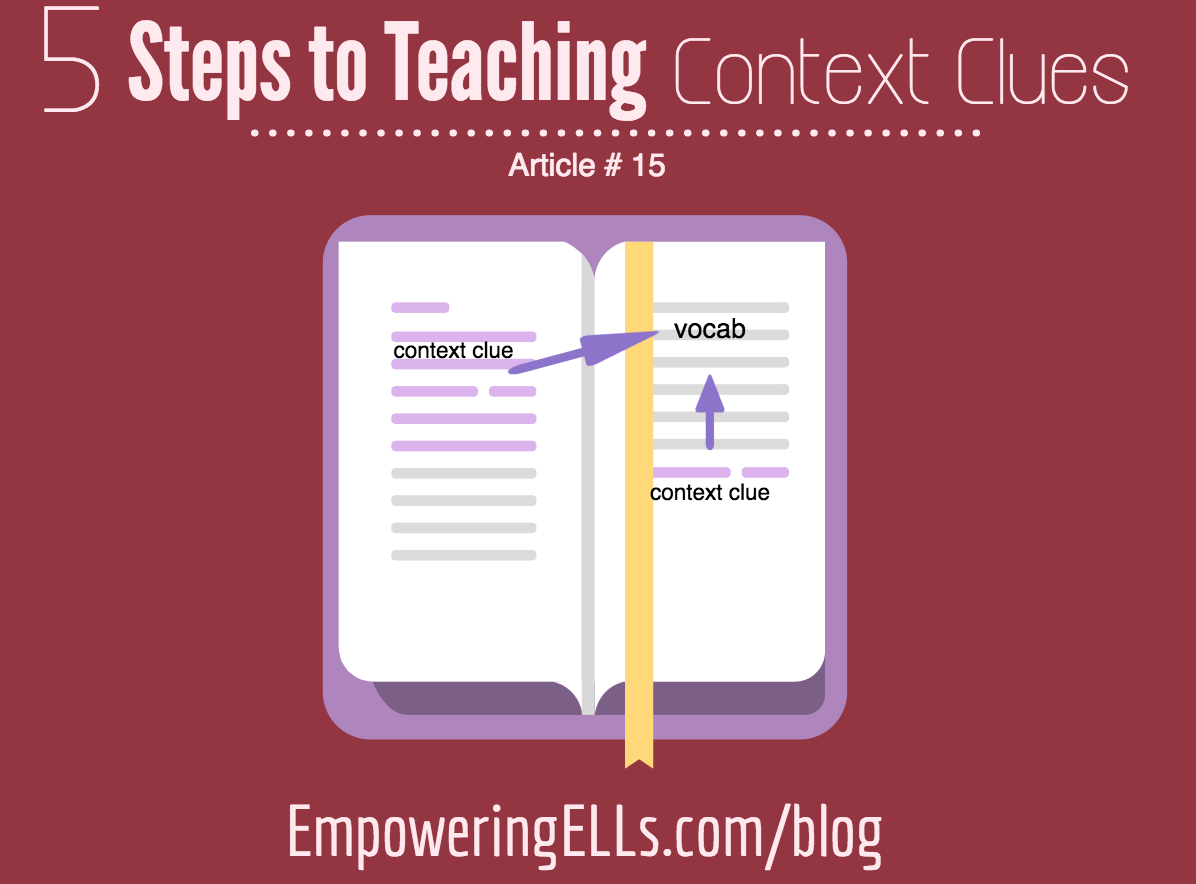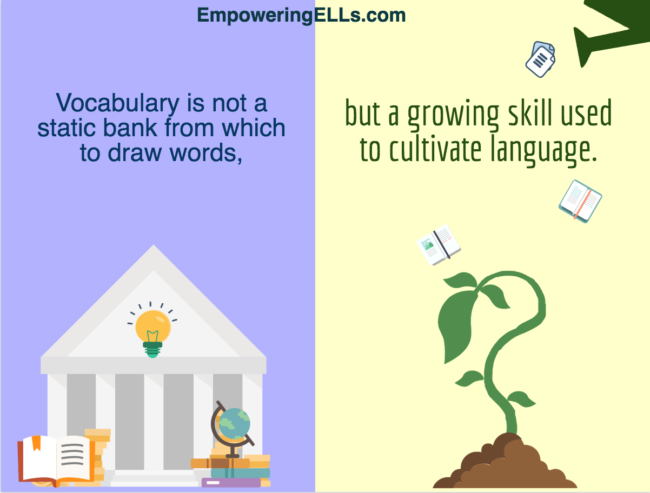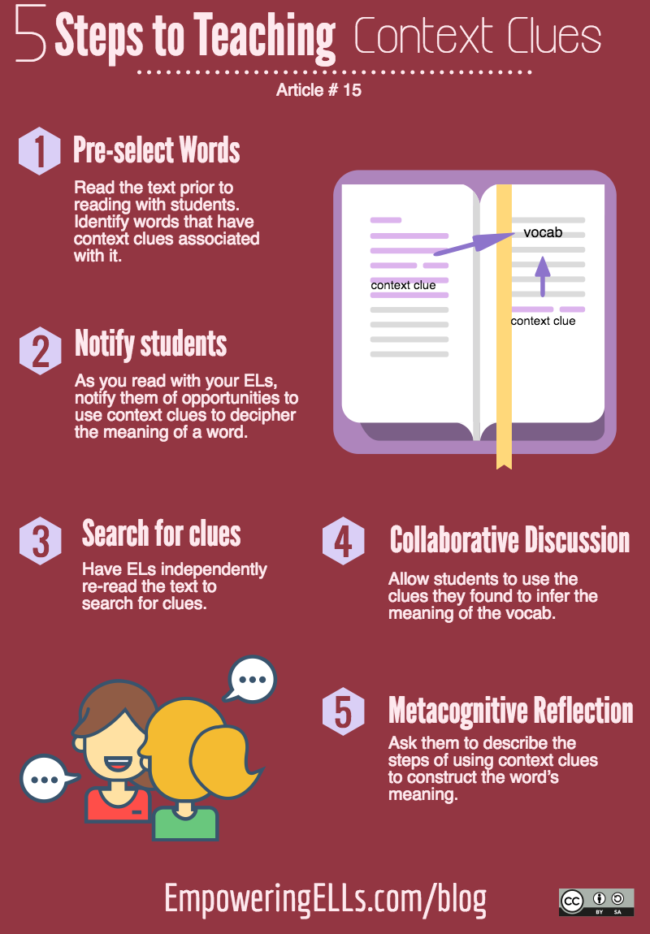Guiding Questions
- Why is teaching vocabulary in context important?
- How can educators teach ELLs to use context clues to decipher vocabulary meaning?
Article’s Goal
The goal of this article is to share a process for teaching ELs to use context clues to decipher the meaning of unfamiliar vocabulary words. It is the first of three articles about vocabulary instruction within the Visible Literacy Series.
Research Says
Effective vocabulary instruction occurs when students have multiple exposures to target words in a variety of contexts, and learning happens when students attempt to use the target words to communicate meaning. Modern research suggests the following practices to develop students’ vocabulary:
- Read-alouds where the teacher explains and discusses the vocabulary.
- Reading and writing activities that encourage the use of new words.
- Teacher modeling of new and high-utility vocabulary usage (Blachowicz et al., 2006; Graves, 2007; Chung, 2012).
- Using target words in sentences that construct a narrative (August et al., 2005).
- Multiple exposures to target words within a variety of contexts (Blachowicz et al., 2006; Beck et al., 2002; Carlo et al., 2008).
Past Practices
I used to see vocabulary knowledge like a bank of words: either students had them or they didn’t. At times, I felt like there was no way I could give ELs all the words they needed to be proficient readers, so I felt helpless and discouraged by the prospect of teaching vocabulary.
Often, I didn’t directly teach it at all. When I did, I had students “look up the word, taught from a boring workbook, or explained the meaning of high-utility words in the air and assumed the students understood what I explained. All of these practices failed to empower ELs to independently decipher the meaning of words because they didn’t encourage ELs to engage with the vocabulary words themselves.
We need to see vocabulary not as a bank of words to deposit but a field to farm . Similar to how farmers use different techniques to grow crops, I have learned ways to design experiences that cultivate ELs’ ability to acquire vocabulary.
Current Practices: Teaching Context Clues
This is my favorite approach to developing ELs’ abilities to decipher vocabulary because it teaches them a transferable skill. Initially, I had difficulty understanding how to teach identifying context clues because, as a proficient reader, I acquired vocabulary subconsciously and didn’t know how to teach this invisible process to my ELs.
Because I was a developing English learner in elementary school and a reluctant reader until high school, I did not possess the necessary reading skills to be academically high achieving. When I started to read, there were so many unfamiliar vocabulary words and, because I wasn’t explicitly taught reading strategies, my only strategy was to keep reading.
As I stubbornly read on, I noticed that, at times, the details before and after the unfamiliar word provided enough context for me to infer the meaning of these new vocabulary words – I had discovered context clues. The goal of this article is to share a process of teaching ELs to use these context clues to comprehend new words.
Below are the five steps for teaching context clues to ELs.
Step 1: Pre-select words
I pre-read the text to look for vocabulary words whose meaning can be derived from the clues within the text. Identifying these target words prior to reading the text with students provides an opportunity to teach ELs to infer using textual clues.
To give context to this process, I’ll share an experience from a recent lesson when I had my 7th graders use their context-clue skill to decipher the meaning of the word “solemn”. We were reading Patricia McCormick’s award-winning novel entitled Sold. The night prior to reading the next section of Sold, I scanned the text for opportunities to use context clues. “Solemn” had enough clues within the text to decipher its meaning.
Step 2. Pause during the guided reading
As we engaged in Visible Reading (my version of a guided close read), I paused at “solemn” and told the students that it has clues within the text to help them understand its meaning. Then I invited them to re-read the sentences before and after “solemn” to find clues that would help them comprehend its meaning.
Step 3. Searching for clues
Students then returned to the text to search for the clues. The ELs annotated their text by highlighting, underlining, circling and connecting the clues to the word. This is often a few minutes of independent re-reading.
Step 4: Collaborative Discussion
Once the ELs identified the clues, they needed to discuss to infer the target word’s meaning. Students then combined the textual clues with their own background knowledge to derive the new meaning. While we were discussing the word “solemn” in Sold, Army identified “solemn as a monk” and “nibble” as clues. He thought:
“Nibble kinda means to chew – like soft chewing. So how does a monk chew? They should not be greedy, and chewing greedily would be making lots of noise. So they chewy politely and peacefully. So maybe “solemn” is trying communicate that this character is chewing peacefully.”
Step 5: Metacognitive Reflection
Most of my processes, structures, and systems are designed to teach them transferable skills, such as using context clues to decipher meaning. But their internalization of the process is accelerated and ingrained when they stop to reflect on the process. For identifying context clues, this is what is what training ELs to think metacognitively sounds like:
“Together, you were able to guess at the meaning of ‘solemn’. This is an important skill when you encounter an unfamiliar word. The skill you demonstrated is called using context clues. I’d like you to Quick Write to describe the steps of using context clues to find the meaning of a vocabulary word.”
Then they’re off to reflect on the steps. Stopping to reflect on the process will foster the internalization of both the steps to do so and their importance.
Using context clues is my favorite approach to teaching vocabulary because I am teaching a skill that they’ll use again and again in other texts from other disciplines. In teaching context clues, I am empowering them to become critical thinkers and independent, attentive readers.
Additionally, I love this approach because it mirrors one of many strategies proficient readers use to understand vocabulary. No workbooks, no drills, no pre-teaching, no stand-alone vocabulary units. Just a reader – exploring and engaging with clues in the text.
Takeaways
- Vocabulary instruction that is taught within context supports language development.
- Teaching context clues develops ELs’ reading skills.
Next Post
In this post, I shared how to teach ELs to use context clues. There are some words, however, that appear often in academic texts across various disciplines but usually do not provide context clues to decipher their meanings. In next week’s post, I’ll share a process to teach ELs how to grow their knowledge of academic vocabulary words regardless of context.
Free Resource
Please feel free to use this resource and share it with colleagues. Please make sure to link back to this resource if you’re going to post it on your website or blog.
August, D., Carlo, M., Dressler, C., & Snow, C. (2005). The critical role of vocabulary development for English language learners. Learning Disabilities Research & Practice, 20(1), 50-57.
Beck, I. L., McKeown, M. G., & Kucan, L. (2002). Bringing words to life: Robust vocabulary instruction. New York: Guilford.
Blachowicz, C., Fisher, P., Ogle, D., & Watts-Taffe, S. (2006). Vocabulary: Questions from the classroom. Reading Research Quarterly, 41(4), 524-539.
Carlo, M. S., August, D., McLaughlin, B., Snow, C., Dressler, C., Lippman, D. Lively, T. J. & White, C. E. (2008). Closing the gap: Addressing the vocabulary needs of English language learners in bilingual and mainstream classrooms. Journal of Education, 189(1/2), 57-76.
Chung, S. F. (2012, September). Research-Based Vocabulary Instruction for English Language Learners. The Reading Matrix, 12(2), 105-120. Retrieved from http://www.readingmatrix.com/articles/september_2012/chung.pdf
Graves, M. (2007). Conceptual and empirical bases for providing struggling readers with multifaceted and long-term vocabulary instruction. In B. Taylor & J. Ysseldyke (Eds.), Effective instruction for struggling readers, K-6 (pp. 55-83). NY: Teachers College.





